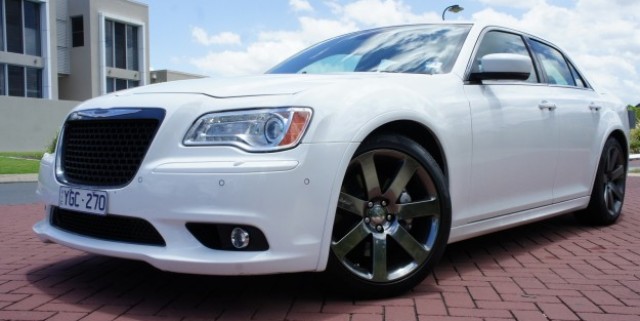
The Chrysler 300 SRT8 is not everyone’s cup of tea. For a start, it’s American, so Europhiles will scoff. Then there’s the monstrous V8 engine that is caged underneath, desperate for attention. If you get over all of that, the in-your-face styling remains the last hurdle.
Of course, it just so happens that it’s up against some local heroes, such as the offerings from HSV and FPV. Big V8 sedans are a relatively niche market these days, but one where allegiances and loyalty are the strongest. But in very tangible terms, the Chrysler 300 SRT8 has plenty going for it against the local duo.
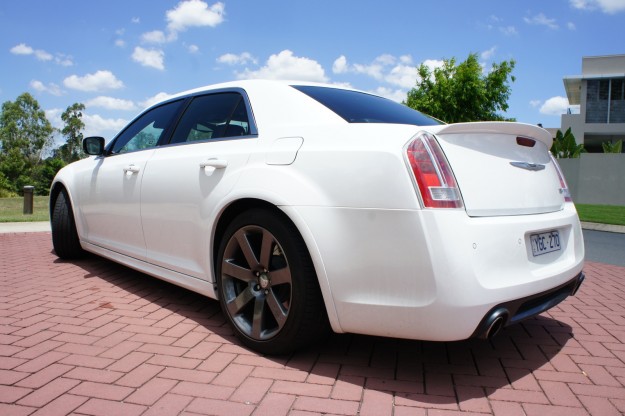
The 6.4-litre SRT8 Hemi V8 is the sort of engine that doesn’t try and kid itself. It may have picked up variable valve timing, electronic throttle control, plus the ability to deactivate four of its cylinders to save fuel, but at the end of the day, it’s a big all-American V8 that drinks its share of fuel and beats its drum loud.
With 347kW of power and 631Nm of torque, it also out-muscles the best that FPV and HSV have to offer. It’ll screech off from the traffic lights and hits 100km/h in around 4.8 seconds. That makes it just as fast as a new manual Porsche 911 Carrera. Chrysler says it uses 13L of fuel per 100km, but that’s only if your right foot is made of feather. Expect figures in the 15s if not higher.
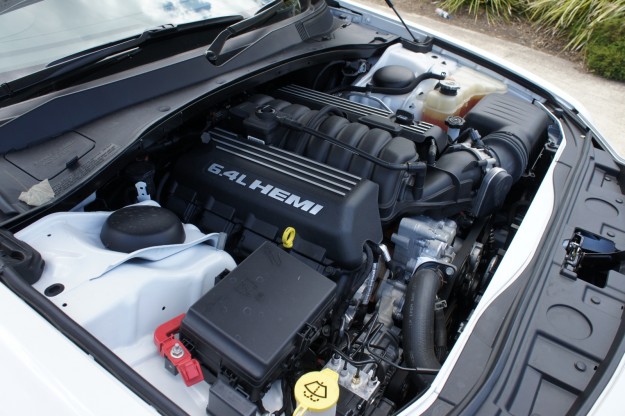
Sadly the 300 SRT8 is stuck in the prehistoric age with a five-speed automatic left in charge to muscle in all that power. Thankfully it’s a pretty decent gearbox and, relying on the torque of the engine, tends to find itself in the right gear the majority of the time. But even so, this is likely to change soon: the Jeep Grand Cherokee SRT8, which makes use of the same engine, recently had its five-speed box replaced with an eight-speeder.
From the outside the Chrysler 300 SRT8 is like an American tourist in most Australian cities; it tends to stand out. Our pearl white test car certainly turned a lot of heads during our fortnight road test, though we weren’t sure if it was always for the right reasons.
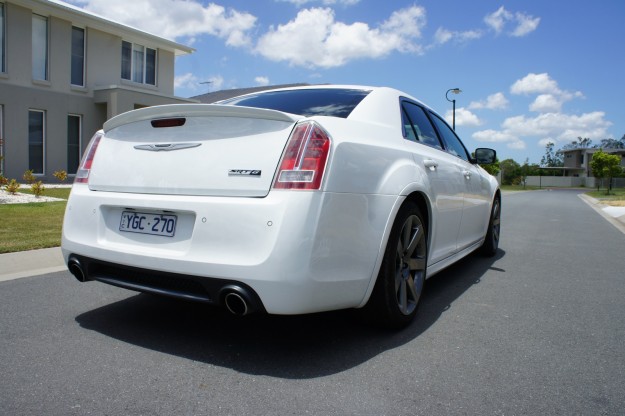
The C-shaped LED daytime running lights (DRLs) go a long way to emphasis the SRT’s road-presence, but it strangely shares this DRL design trait with the Mercedes-Benz C-Class. Thankfully the bold black-mesh grille dismisses any possibility of getting the two confused from afar.
As with its predecessor, the 300 SRT8 follows the same principle of high door lines and as little window space as possible. It’s the gangsta look. You would think this would hinder visibility but behind the wheel it’s actually not too bad and the reversing camera certainly helps its cause.
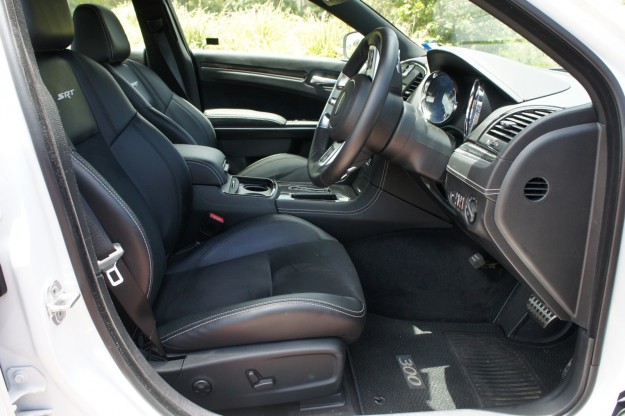
As for the interior, the American-ness is not as obvious as before. There’s certainly been an attempt to improve cabin ambience and the general feel of the interior is by no means cheap for its class. Our test car came with Napa leather trim (100 percent real leather) with perforated suede, but the optional $2,200 ‘Leather Interior Group’ package added an even higher grade of leather trim as well as ‘luxury’ floor mats, which strangely enough, looked like regular floor mats.
The chunky SRT steering wheel feels good to grip and comes with controls for both the audio and active cruise control systems. Being an American car both the front and rear seats can accommodate larger than average passengers and you’ll have no trouble fitting three adults in the back seat – with rear air vents an additional bonus.
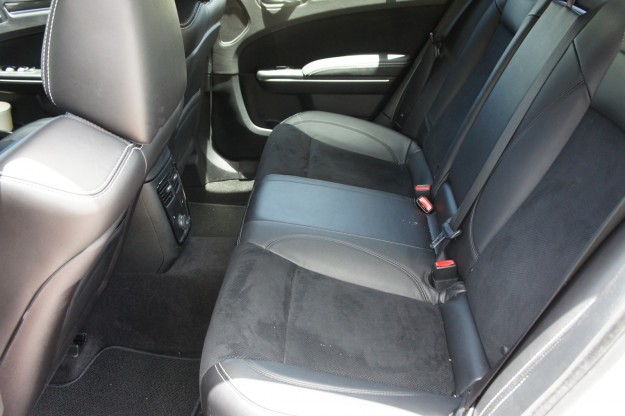
Given that a Chrysler 300 SRT8 is unlikely to ever see an apex (at least on a track) we should quickly get cornering criticism out of the way. If you want to tackle bends repeatedly, look elsewhere. This is an American car and although it has improved substantially in the suspension department (with much better body control and two-stage adaptable dampers), it’s still not engineered with sweeping bends in mind.
What it does do really well, is go fast. Very fast. From a standstill there’s no denying the Hemi V8 has got serious balls. It pulls and pulls and just when you thought it was going to run out of puff, it changes up and keeps pulling. There’s that instant feeling of sudden power as you hammer the right pedal and there’s something special about a car that weighs two tonnes (1983-2012kg depending on equipment) getting up to speed so damn quickly. Stopping the beast are 4-piston Brembo calipers pressuring 360mm discs (350mm for the rear).
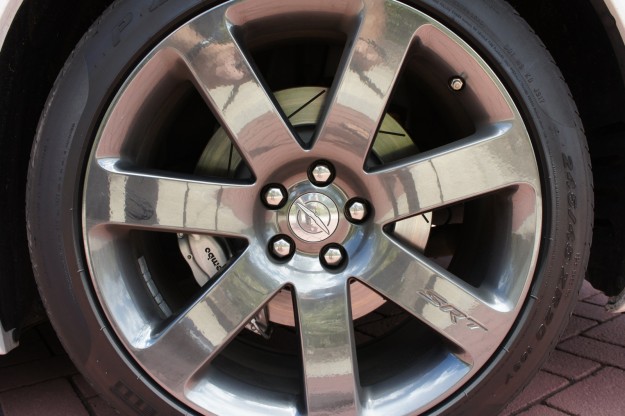
Additionally, you have to give credit to the folks at SRT for sticking with a fully hydraulic steering system when the world has moved to electronic (even Porsche). Though in theory a hydraulic system is meant to offer better feel and feedback, the steering is hardly an SRT8 strong point. It tends to be light at the best of times and although precise and responsive, is otherwise without much feedback on bumps and corners. It’s like playing Forza on the X-Box without the controller or steering wheel vibrating.
The Chrysler 300 SRT8 rides on 20-inch dark-chrome alloys wrapped in Pirelli tyres. Despite the large wheels and low profile tyres, ride quality is actually not too bad, thanks to its finely-engineered suspension setup.
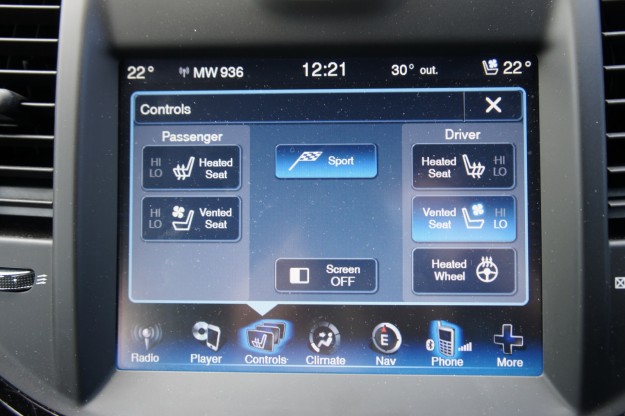
It’s worth noting that Chrysler hasn’t skimped on technology for both entertainment and safety. There’s an 8.4-inch touch screen with USB and Bluetooth connectivity, a 19 speaker sound system (including subwoofer and 900 watt amplifier) and a monitoring system that can report 0-100km/h and 400 metre acceleration times, braking response and lateral g-force performance.
To be fair, the satellite navigation system map display looks like something out of the bargain bin from JB HiFi, with poor resolution and modest detail.
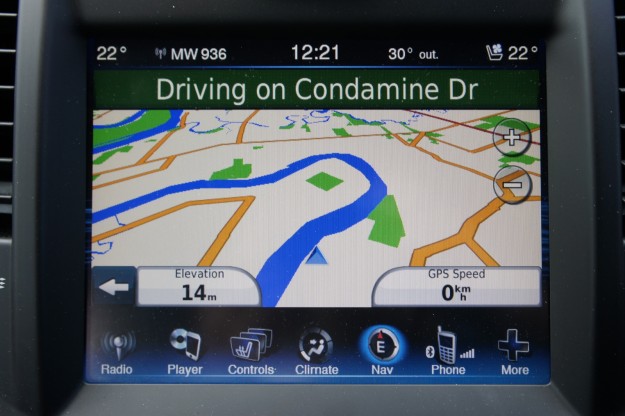
On the safety side, the 300 SRT8 gets forward collision warning and adaptive speed control, which means a radar monitors the objects in front and can warn if a collision is imminent but can also be put in charge of maintaining a set distance from a vehicle in front. Not exactly new technology but worthwhile nonetheless. There’s also rear parking sensors and a full complement of airbags.
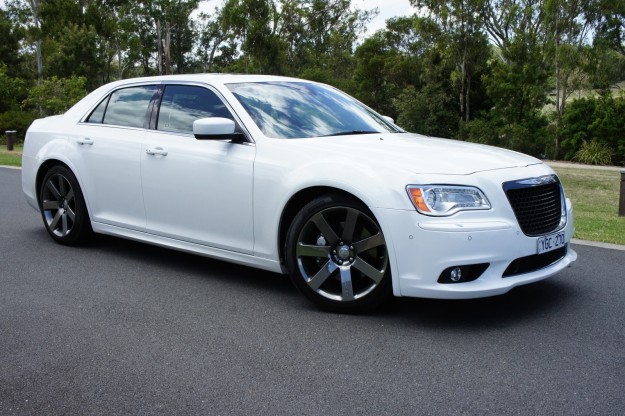
Overall the Chrysler 300 SRT8 is just as good as the local offerings, if not better, in some regards. It may not command the same level of respect from Aussie car enthusiasts as the hotted-up Ford and Holden products, but as a result, it’s a little more under-the-radar, and dare we say even a tad classier, than the local rear-drive sports sedans.





